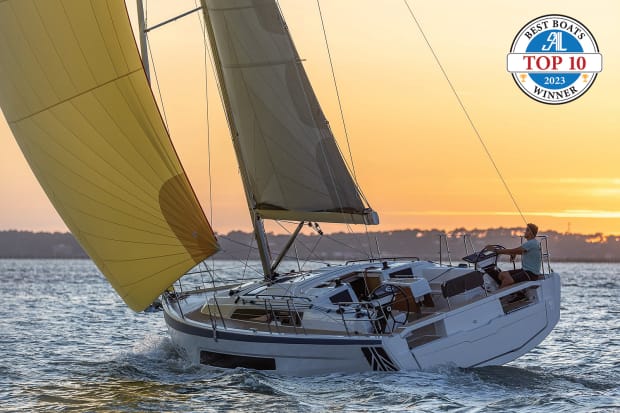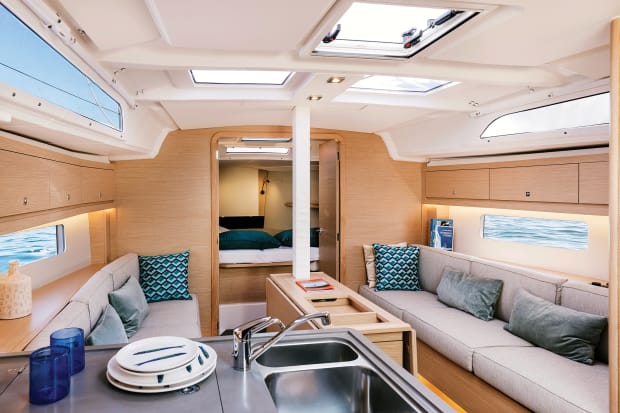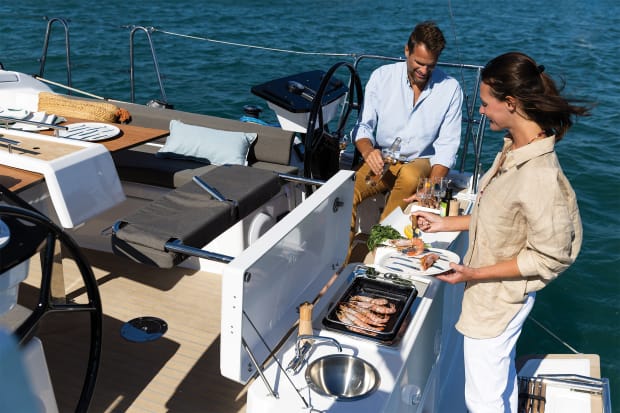
French builder Dufour Yachts has rolled out another new design bringing their line to eight models from 32 to 61 feet. The new Dufour 37 slots in just above the 32-foot baby of the family, and it replaces the previous Dufour 360 from three years ago. Although the hull actually measures only 33 feet, her test sail proved her to be the definition of a little big boat.
When compared to the 360, the Dufour 37 has fuller sections forward that create volume below, especially in the master stateroom where owners can now sleep head-forward. The forefoot is deeper for less pounding into head seas, and the fractional, deck-stepped Z-Spar rig has been moved aft about a foot to increase the size of the foretriangle and therefore the headsail. The rig is also taller with a higher aspect ratio and another 20 square feet of sail area (by Elvstrom Sails) for better performance. A self-tacking jib is standard, but you can opt for a 108% overlapping headsail.
Like her predecessor, the 37 has twin wheels but a single spade rudder, as is standard for Felci designs that emphasize a more direct feel at the helm. Below the waterline is a 6-foot, 3-inch, L-shaped fin keel with a bulb, and on deck, the bowsprit does triple duty by providing an attachment point for a screecher, moving the anchor away from the stem, and adding length overall.
The cockpit is massive for a boat in this class with an enormous folding table, surprisingly good handholds, and a new grill in the transom area. Twin wheels sit on stylish angled pedestals that open up the cockpit for easier movement.
The Eno plancha grill and small round outdoor sink are worth a mention because they’re unexpected on a boat of this size. The transom drops to form a place to stand while you cook al fresco. If that doesn’t start the tongues in the anchorage wagging, nothing will.
Two niggly points: First, there’s no opening anchor locker, and the only way to access the anchor chain is via the forward cabin. That’s not ideal, especially when the chain piles up and you have to jump in and out of the forward cabin to deal with it. Second, you have to upgrade to the performance or ocean equipment packs to add more winches (the standard is two) that make line handling easier.

Living
As already mentioned, the boat is quite round and full in the foresection, and that’s really noticeable below. The owner’s suite in the bow is quite liveable, and with its bifurcated door open the boat feels much larger than the hull length suggests.
Layout choices include two or three cabins and a single head. To my mind, the most practical arrangement would include two cabins and a stowage space to starboard that’s accessible via the head as well as from the cockpit. In this iteration, the head is larger, and there’s room for a small nav desk aft of the starboard settee.
The L-shaped galley is compact but workable with a two-burner Eno stove, a GE microwave, and a top-loading refrigerator. To their credit, Dufour managed to squeeze in a double sink, greater headroom, bottle storage, and a mammoth drop-leaf dining table mirroring the one in the cockpit. Four diners will have plenty of elbow room. Dufour seems to have a newfound focus on inflatables for enhancing living spaces. While our test boat did not have any—so we can’t comment on how well they work—there are options for an inflatable sunpad on the bow and another inflatable filler cushion in the saloon that makes one settee into a double bed.

Moving
We tested hull #2 of the design on the flat waters of the Chesapeake Bay in 9-12 knots of true breeze. In 9 knots of wind, we sailed 6.5 knots on a beam reach and inched up to 35 degrees apparent wind angle (AWA) where we still held on to 6.2 knots. The top-down gennaker added some fun and we carried it up to 60 degrees AWA.
You know it’s a good day when you come away from a sail pleasantly surprised as we did. Even in small gusts we stayed upright as the boat leaned on her hard chine to a max of only 18 degrees heel. The helm was light and so responsive that we had to tack more slowly and mindfully so we wouldn’t leave hockey sticks in the wake behind us.
Our test boat was fitted with the upgraded 30-hp Volvo Penta diesel (standard is 19-hp) which made quick work of our motor back to the marina. At 2,100 rpm we found a nice cruise at 6.6 knots, and when pushed we topped out at 7.8 knots and 3,100 rpm. A surprising option is the SidePower bow thruster. It’s not necessary but nice to have in a pinch. Another bonus—the emergency tiller has easy access, and the boat is small enough that you could potentially effectively maneuver with it if needed.

Overall Impressions
The Dufour 37 promises to become a worthy successor to the 360 primarily because the builder focused on the two things that make owners happy: increased comfort and better performance. If those two criteria are met, nobody will be getting out the tape measure and arguing about the LOA on this smaller model that acts, looks, and feels like a bigger boat.
LOA/LWL 35’4” / 30’7”
Beam 12’6”
Draft 6’3”
Displacement 14,874 lbs
Ballast 4,100 lbs
Sail Area 646 sq ft
Power 19-hp Volvo Penta diesel (30-hp as tested)
Designer Felci Yacht Design
Builder Dufour Yachts/dufour-yachts.com
Price as tested $210,000 at time of publication
March 2023








